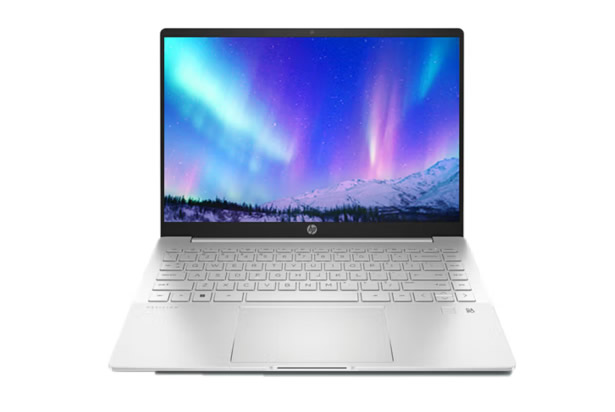HP recently launched a new generation of Pavilion hin and light notebook. The new model takes “light and thin” as the main selling point, and has been upgraded in terms of performance, screen, appearance, and intelligent experience. In addition to the processor upgrade to the 12th generation Intel Core platform, the performance has been greatly improved, and the screen performance of the Pavilion 14-eh is also very eye-catching. It adopts a 2.8K 90Hz OLED eye protection screen: the use of OLED screen makes the color and contrast performance of the screen more accurate and delicate; the 90Hz refresh rate improves the experience of gaming and watching movies. In addition, the intelligent voice system has also been upgraded in an all-round way to provide users with a better experience.
What we are going to review is the Pavilion 14-eh high configuration version, which is equipped with the 12th generation Intel Core i7-12700H processor. Other hardware aspects include Iris Xe 96EU graphics, 16GB dual-channel memory, etc.; so how does this new product perform? Can it achieve both thinness and high performance? The following we will review to provide a comprehensive interpretation.
CPU
Thanks to the updated hardware configuration, the performance of the Pavilion 14-eh is very exciting. Especially the processor part, it is equipped with the 12th generation Intel Core i7-12700H processor. Based on Intel 7 process and Hybrid hybrid architecture, it includes 6 P-Cores + 8 E-Cores with a total of 14 cores, 20 threads, 11.5MB L2 cache, 24MB L3 cache, and the highest single-core turbo frequency can reach 4.7GHz.
In order to put this H-series standard-pressure high-performance processor into a thin and light body, the Pavilion 14-eh has fully optimized the heat dissipation module. Equipped with a new cooling system, the upgraded LCP ultra-thin fan has an overall increase of 36% in size and an 84% increase in airflow. Dual three-phase motor fans and dual-wide heat pipe design can take away heat faster, keeping the device cool and refreshing when running at high energy.
Entering the pre-installed HP Control Center and switching to performance mode, the Pavilion 14-eh’s CPU release is stable to 45W at 28°C room temperature, and peak power consumption can reach over 60W, while the core temperature of the chassis are relatively well controlled. For playing games, video editing, 3D rendering, and other high-load applications, the higher power release allows the processor to run at a high frequency for a long time, and the overall performance is more powerful. Of course, for simple web browsing, document processing and other office scenarios, you can switch to a balanced mode to limit power consumption, reduce fan noise and improve endurance while meeting basic efficiency.
GPU
In the graphics card part, this Pavilion 14-eh is the UMA version, inheriting the Iris Xe 96EU core graphics and using 3DMark to test it. In the Night Raid project, the graphics card score is 16551.
In addition to the UMA version, the Pavilion 14-eh also provides a version with an RTX 2050 graphics, which has 2048 CUDA cores, 4GB GDDR6 video memory, and supports advanced technologies such as DLSS deep learning oversampling and RTX real-time ray tracing.
Appearance
The Pavilion 14-eh uses a three-sided metal body, and the frame is treated at right angles. The overall design is relatively simple and capable, without excessive extra decoration.
It is worth noting that the A, C, and D sides of the Pavilion 14-eh are made of aluminum alloy, which further highlights the texture of the fuselage. At the same time, keycaps, frames, speaker casings, and other parts are made of marine plastic materials, which are environmentally friendly materials that can be recycled. The Pavilion 14-eh is as thin as 16.5mm and weighs about 1.4kg. The advantages of portability are well inherited.
The Pavilion 14-eh increases the touchpad area by 20% compared to the Pavilion 14-cd and Pavilion 14-dh; combined with the 1.3mm key travel rebound, and the 18.4mm large key spacing keyboard, the overall operation, and typing experience have been further improved.
The notebook is equipped with two full-featured USB 3.2 Gen2 Type-C ports (supports 90W PD charging and DP display output), two USB 3.2 Gen1 Type-A ports, one 3.5mm headphone microphone port, and one HDMI2.1 interface, one Micro SD card slot.
Screen
The screen part is also the upgrade focus of the Pavilion 14-eh. It is equipped with a 14-inch 16:10 2880×1800 resolution ultra-clear OLED display, which can achieve pure black level true color accuracy and 1000000:1 contrast ratio; and supports 90Hz high refresh rate and <1ms rapid response time; 100% DCI -P3 ultra-wide color gamut coverage, 10 bit display color depth in HDR mode, HDR 500nits high brightness; and obtained VESA True Black HDR 400 professional certification, TuV+Eyesafe low blue light dual certification, etc.
The Pavilion 14-eh significantly narrows the bezels at the top and bottom of the screen, further increasing the screen-to-body ratio to 87%.
On top of the bezel, it integrates an HP TrueVision top-mounted 5MP HD camera and dual-array microphones, combined with practical features such as TNR noise reduction, AI ambient sound cancellation, intelligent focus-tracking, intelligent fill-in beauty, and network assistants to provide a good user experience in scenarios such as remote meetings and online classes.
